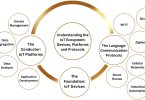The eternal wish of mankind to predict what is going to happen has always been a great mystery for people. Forecasting within the finance field is a necessity because results depend on market movements and the methodologies of the forecasting process will always be of the main concern. Among the modern technologies, a sophisticated one is called neural networks and is widely used in different branches, such as banking and finance. This technology is very helpful in fighting financial activities.
Neural Networks in Financial Markets
Take an example of a network that has interconnected nodes, and looks like the brain’s complicated structure. This is the fundamental structure of neural networks in general. These nodes carry out the functions of information processing, assimilation of patterns and adjustment of nodes interconnection to refine the predictive accuracy over time. In essence, they perform the role of smart students, examining data and improving their accuracy with every prediction.
Applications of Neural Networks in Financial Forecasting is the use of computational techniques to predict financial outcomes, such as stock prices, exchange rates, or the financial health of a company.
Financial markets are a complex mix of details that are in turn affected by several factors, including economic data and media commentary.
Neural networks seem to be natural at dealing with it. They are subjected to training on large-scale datasets that cover all types of historical market data including news reports and other related information. Recognizing implicit cues and connections within this data, neural networks develop the ability to forecast market developments.
Exploring Neural Networks as Predictive Tools in Financial Sphere
Although neural networks are promising, they can never be as powerful as they are dependable predictors. The ability to make precise forecasts has a lot to do with the quality and the extent of the training data. Apart from this, unpredictable situations can also undermine even the most advanced neural network models.
Pros and Cons of Neural Networks in Financial Modelling
- Exposure of Hidden Patterns: The ability of neural networks to uncover intricate correlations within datasets, which evades regular statistical methods.
- Adaptability: As a response to changing market dynamics, neural networks can take advantage of the ability to learn and adapt to new situations by changing the algorithms.
- Data Sensitivity: The effectiveness of the predictions will depend on the quality and level of the training data.
- Opaqueness of Operation: The networks of neural networks that function in an intricate way may be an obstacle to the understanding of the reason behind the reasoning of their predictions.
The Rise of Self-Learning Neural Networks
The neural networks in place of traditional statistical models in which the rules are predefined are self-learning systems. They are trained on big data stores comprising of stock prices, economic indicators, news archives, and social media trends. Human beings cannot see these relationships and patterns which are too subtle and hardly noticeable to the human eye, in contrast to neural networks that find them. Eventually, the network becomes more precise with better links built up.
Neural Networks in Enhancing Financial Forecasts
The value of artificial intelligence in financial forecasting is the main idea.
The financial markets play the role of networked systems, and such networks are affected by different factors (for instance, economic indicators, geo-political incidents and global tempers). Unlike human beings, neural networks are capable of handling the complexity of natural languages without being constrained by linguistic structures.
Here’s how neural networks can be leveraged for financial forecasting:
Pattern Recognition
Neural networks are the best at discovering hidden connections in extensive datasets regardless of how apparently different two elements might appear to be.
Adaptability
Unlike fixed models, neural networks contain the ability to constantly learn and modify themselves based on the changing market conditions. The more recent data that is being put out, the more it gives the network the ability to fine-tune its understanding and maybe also improve the accuracy of its forecasts.
Non-Linear Relationships
The traditional models frequently produce misleading results because they are unable to reflect non-linear dependencies among variables. On the other hand neural networks are highly adaptable to such complex interactions and provide a more holistic perspective of market behaviour.
Limitations in Financial Analysis
Despite their promise, it’s imperative to acknowledge the limitations of neural networks…
- Data Reliance
- The neural network’s performance is data-driven, meaning that the quality and amount of training data determines the prediction effectiveness. In this case, if data is insufficient or incorrect, it can lead to unreliable forecasts.
- The Opacity of Operation
- The incredible network of nerve cells can make it difficult to understand the basis of a specific prediction, which can add to the problems faced while checking the validity of those predictions.
- Risk of Overfitting
A neural network trained on a small dataset may give importance to certain patterns more than others, which will result in high chances of overfitting and low predictive accuracy on unexplored data.
Role of Humans in Neural Network-Based Forecasting
Humanized AI should be a combination of both Human Expertise with AI.
While neural networks are useful for this task, the fact that they are not a cure-all for financial forecasting is well-known. Human involvement remains indispensable for several reasons:
Market Insight: It is the human experts who are endowed with the ability to understand all the complex aspects of the economics and geopolitical factors, which are very important when it comes to putting neural network-generated predictions into perspective and refining them.
Risk Assessment: Neural networks have an impressive ability to identify patterns but it is less efficient in assessing risks. Network analysis will put human investors in a position where they will need to evaluate the investment risks of the networks.
Ethical Considerations: AI has been an important development in finance that is also accompanied by ethical considerations like algorithmic bias and possible manipulation. The responsible use of neural networks in financial forecasting necessitates the involvement of people to monitor the process.
Future Directions for Neural Networks in Finance
Neural networks are still in a “juvenile” stage at the moment in the financial sphere. With the continuous innovations in technology and wide spread of data accessibility, it is expected that their functionalities will be greatly improved in the future.
The following potential future trajectories may shape the landscape:
- Integration with Diverse AI Techniques: The interaction of AI tools like neural networks with machine learning and NLP may yield more accurate and meaningful financial projections.
- Advancements in Explainable AI (XAI): Research in Explainable AI (XAI) will never cease since the goal is to make neural network predictions more explainable and transparent. This effort is designed to enlarge trustability and promote a smooth collaboration of AI-generated considerations into a human decision-making framework.
- Democratization of AI: The arrival of new cloud computing infrastructure and user-friendly platforms is probably going to result in the democratization of access to neural network-based forecasting tools. This may open up these instruments to an increasing number of investors and financial institutions whose activities are not restricted to certain capital or income levels.
Conclusion
Neural networks do not work like a crystal ball, they are a powerful tool on the way to the intricacies of financial forecasting. Because we can explore their capabilities as well as be aware of their limitations, we are laying the groundwork for a future where human and machine intelligence cooperate to make smart financial choices.








Leave a Comment